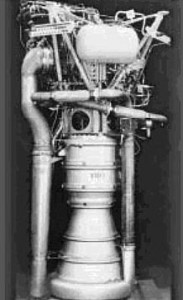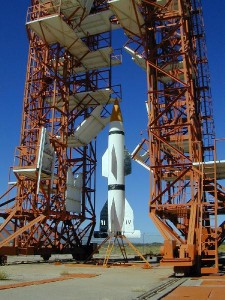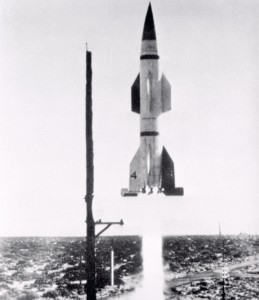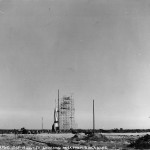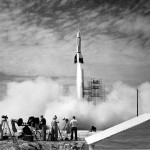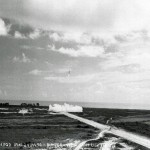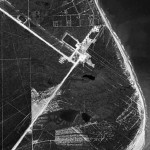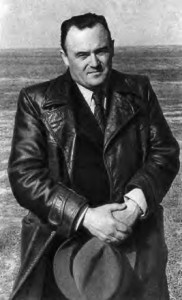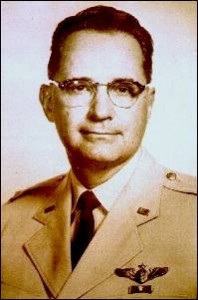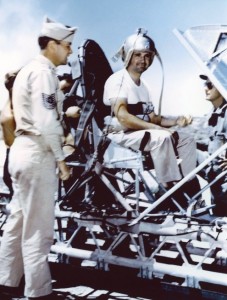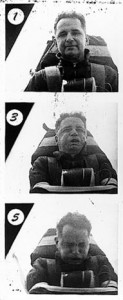March 2: The fist full-thrust test of the 75,000-pound thrust liquid (EtOH/LOX) rocket engine (XLR-43-NA-1) in the Navaho program was conducted. This engine was the first to solve the problem of combustion instability, which had limited the size of the German rocket engines in World War II.
March 3: Another space medicine symposium, “The Biological Aspects of Manned Space Flight” was held at the University of Illinois Medical School in Chicago. It was sponsored by Gen. Harry Armstrong and Dr. Andrew Ivy and was attended by Werner von Braun and Dr. Strughold. Only a small audience (25) was expected, but instead there developed a standing room only crowd (estmated at 275) and it also received large amount of press coverage. The presentations were published as “Space Medicine”, edited by Dr. John Marbarger and this quickly sold out several printings. This conference led to discussions to form a permanent space medicine organization.
Program:
Space Medicine in the United States Air Force,
Major General Harry G. Armstrong USAF MC
Multi-stage Rockets and Artificial Satellites,
Wernher von Braun
Physiological Considerations on the Possibility of Life
Under Extraterrestrial Conditions,
Dr. Hubertus Strughold
Astronomy and Space Medicine,
Heinz Haber, Ph.D.
Orientation in Space,
Dr. Paul A. Campbell
Bioclimatology of Manned Rocket Flight,
Konrad Buettner Ph.D.
Ref – Marbarger JP. “Space Medicine”. University of Illinois Press.1951. Only 23,000 copies in print.
April 1: The German missile team headed by Dr. Wernher von Braun had been completely moved from White Sands, N. Mex. to Redstone Arsenal at Huntsville, Ala.
May 19: The first Army Hermes A-1 rocket was test fired at White Sands.
 Hermes Launch List (4.7 KiB)
Hermes Launch List (4.7 KiB)
May 31: Luncheon meeting of the “Informal Committee Interested in Space Medicine” at the Aero Medical Association meeting was held. It was chaired by Dr. Andrew Ivy and attended by eighteen aerospace medical experts (25 were invited to attend by Dr. John Marbarger and Dr. Paul Campbell). The fifteen attendees listened to formal presentations by Dr. H. Strughold and Dr. H. Haber. Dr. Strughold predicted explosive growth in space exploration and the field of space medicine. The talk is summarized in  Space Medicine Branch History 1950-1957 By Dr. Paul Campbell (189.0 KiB)
Space Medicine Branch History 1950-1957 By Dr. Paul Campbell (189.0 KiB)
CHARTER MEMBERS IN ATTENDANCE AT FOUNDING MEETING
Dr. E. J. Baldes Dr. Fritz Haber
Col. R. J. Benford Dr. James Henry
Brig. Gen. Otis 0. Benson, Jr. Dr. V. K. Henschke
Dr. K. Buettner Dr. A. C. Ivy
Dr. Paul A. Campbell Dr. J. P. Marbarger
Capt. Ashton Graybiel Dr. H. J. Schaefer
Dr. V. Guillemin, Jr. Lt. Col. B. Strickland
Dr. Heinz Haber Dr. H. Strughold
CHARTER MEMBERS ELECTED AT FOUNDING MEETING
Maj. Gen. H. G. Armstrong Rear Adm. B. Groesbeck, Jr.
Dr. L. H. Bauer Dr. F. G. Hall
Capt. A. Behnke Dr. J. Kaplan
Dr. D. Beischer Capt. W. E. Kellum
Capt. L. D. Carson Dr. G. J. Kidera
Dr. D. B. Dill Dr. W. R. Lovelace, II
Dr. W. 0. Fenn Capt. J. R. Poppen
Lt. Col. A. P. Gagge Lt. Col. H. M. Sweeney
Dr. 0. Gauer Lt. Col. J. M. Talbot
Dr. C. F. Gell Col. A. D. Tuttle
It was proposed and approved (some members were adamantly opposed) to petition the Aero Medical Association Council for section/branch status for an organization dedicated to space medicine. The Aero Medical Association Council had recently approved a change in the organization’s constitution to allow for branch associations within the parent organization. The committee to petition the Council was chaired by Dr. Ivy (considered to be the first un-elected President) with Dr. Marbarger as the Secretary (who wrote the first organizational constitution). Dr. Otis O Benson left the meeting and reported to the Council (which was then also in session) of the ongoing discussions.
Space Medicine Branch History 1950-1957 by Dr. Paul Campbell
 SMB History 1979 (774.7 KiB)
SMB History 1979 (774.7 KiB)
 SMB Hx 1990 (69.2 KiB)
SMB Hx 1990 (69.2 KiB)
 Editorial Comment - Space Medicine (55.2 KiB)
Editorial Comment - Space Medicine (55.2 KiB)
 SMB 1951 (41.0 KiB)
SMB 1951 (41.0 KiB)
June 25: The Korean War begins with the invasion of South Korea by North Korea.
July 24: Bumper No. 8, a combination of V-2 and Wac-Corporal was launched from Launch Pad 3 at Cape Canaveral and reached a total distance of 25 miles in a horizontal distance test; this was the first missile launch at the Cape. The V-2 exploded.
- Cape Canaveral 071950
- V-2-Bumper-Cape-Canaveral
- Bumper-Cape-Canaveral-072450
- Cape Canaveral 1951
July 29: Bumper No. 7 reached a velocity of Mach 9 at Cape Canaveral, the highest yet attained. This was the last of the Bumper Project launches.
October 16: Dr. John Marbarger, Acting Secretary of the embryonic organization forwarded a copy of a petition which was to be submitted to the Executive Council of the Aero Medical Association as well as a draft copy of a constitution.
October 26: Sergei Korolev becomes the director of OKB-1 (eventually became Energia).
 Sergei Korolev (9.5 MiB)
Sergei Korolev (9.5 MiB)
During 1950: USAF Flight Surgeon Capt. John Paul Stapp experiences a de-acceleration force of 46.2 +Gx in a rocket sled at Muroc AFB (now Edwards AFB).
Journal of Aviation Medicine articles:
Haber, F, Haber, H. Possible methods of producing the gravity-free state for medical research. xx JAM 1950 21: 395-400.
 21050395-1 (111.4 KiB)
21050395-1 (111.4 KiB)
 Parabolic (490.6 KiB)
Parabolic (490.6 KiB)
Editorial Comment. Space Medicine. JAM 1950 21: 359-361.
 21050359-1 (55.2 KiB)
21050359-1 (55.2 KiB)
Krebs AT. Possibility of Biological Effects of Cosmic Rays in High Altitudes, Stratosphere and Space. xxxxxxxxxxxx JAM 1950 21: 481-494.
 21040481-1 (546.6 KiB)
21040481-1 (546.6 KiB)

